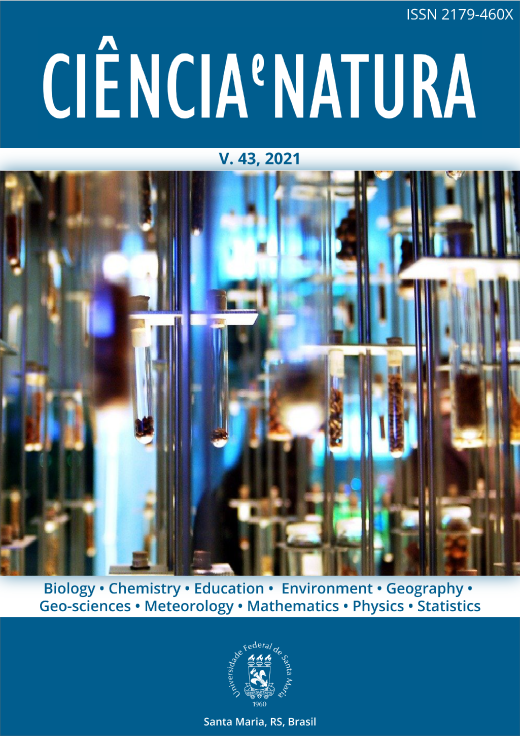The use of digital technologies in calculus teaching at UFPel: An analysis of GAMA project initiatives
DOI:
https://doi.org/10.5902/2179460X40950Keywords:
Teaching and learning calculus, Digital information and communication technologies, Collaborative EnvironmentsAbstract
This paper sought to address the use of technologies aimed at enhancing mathematical learning at the university level. We sought to identify impacts of the GAMA project initiatives: Mathematics Support Group of the Federal University of Pelotas - UFPel that use Digital Information and Communication Technologies (TDIC) to create and make available audiovisual support resources and collaborative virtual spaces. The first part of this study reports the project experience in the production of pedagogical videos. Among other aspects, a presentation was made of the process of elaboration and availability of the videos in the referred channel, as well as their use in GAMA activities. The second part of the work reported on the project experience with the WhatsApp groups, which were created with the goal of providing collaborative virtual spaces. In particular, we present the result of an investigation that analyzed the content of 3,647 messages posted by students, scholars and teachers in the two existing groups. The research results allow us to conclude that the resources recently added to GAMA activities represented important alternatives to enhance the teaching / learning process in mathematics, resizing and resignifying the space traditionally assigned to the classroom.
Downloads
References
BORBA, M. C.; OECHSLER, V. Tecnologias na educação: o uso dos vídeos em sala de aula. Revista Brasileira de Ensino de Ciência e Tecnologia, Curitiba. 2018; v. 11, n.2, p. 391 - 423.
BARDIN, L. Análise de Conteúdo. São Paulo: Edições 70; 2016.
CATAPANI, E. C. Cálculo em Serviço: um estudo exploratório. Bolema, Rio Claro – SP. 2001; v.14, n.16, p. 48 - 62.
DÖRR, R. C.; MUNIZ, C. A.; PINA NEVES, R. S. Operações algébricas e funções como obstáculos à aprendizagem no cálculo. In: 1 Simpósio Latino-Americano de Didática da Matemática. 2016; Bonito, MS. Anais do 1 LADIMA, Bonito, MS.
GALLO, P.; PINTO, M. D. G. Professor, esse é o objeto virtual de aprendizagem. Tecnologias na Educação. 2010. p. 1-12.
GOMES, E. Ensino e aprendizagem de cálculo na engenharia: um mapeamento das publicações nos COBENGEs. In: Encontro Brasileiro de Estudantes de Pós-graduação em Educação Matemática. 2012; Canoas. p. 1-9.
MORAN, J. M. Ensino e aprendizagem inovadores com tecnologias. Informática na Educação: Teoria & Prática, Porto Alegre. 2000; v. 3, n. 1. p. 137-144.
MORAN, J. M.; MASETTO, M. T.; BEHRENS, M. A. Novas Tecnologias e Mediação Pedagógica. Campinas: Papirus; 2013.
NETO, A. A. O.; VERSUTI, A.; VAZ, W. F. Perspectivas para o uso do WhatsApp no estímulo à aprendizagem dos sujeitos. In: Semana de Licenciatura e Seminário da Pós-graduação em Educação para Ciências e Matemática. 2016; Goiânia. p. 222-236.
REIS, F. S. A tensão entre rigor e intuição no ensino de Cálculo e Análise: A visão de professores-pesquisadores e autores e livros didáticos [tese]. Campinas: Faculdade de Educação, Universidade Estadual de Campinas; 2001. 302 p.
Published
How to Cite
Issue
Section
License
To access the DECLARATION AND TRANSFER OF COPYRIGHT AUTHOR’S DECLARATION AND COPYRIGHT LICENSE click here.
Ethical Guidelines for Journal Publication
The Ciência e Natura journal is committed to ensuring ethics in publication and quality of articles.
Conformance to standards of ethical behavior is therefore expected of all parties involved: Authors, Editors, Reviewers, and the Publisher.
In particular,
Authors: Authors should present an objective discussion of the significance of research work as well as sufficient detail and references to permit others to replicate the experiments. Fraudulent or knowingly inaccurate statements constitute unethical behavior and are unacceptable. Review Articles should also be objective, comprehensive, and accurate accounts of the state of the art. The Authors should ensure that their work is entirely original works, and if the work and/or words of others have been used, this has been appropriately acknowledged. Plagiarism in all its forms constitutes unethical publishing behavior and is unacceptable. Submitting the same manuscript to more than one journal concurrently constitutes unethical publishing behavior and is unacceptable. Authors should not submit articles describing essentially the same research to more than one journal. The corresponding Author should ensure that there is a full consensus of all Co-authors in approving the final version of the paper and its submission for publication.
Editors: Editors should evaluate manuscripts exclusively on the basis of their academic merit. An Editor must not use unpublished information in the editor's own research without the express written consent of the Author. Editors should take reasonable responsive measures when ethical complaints have been presented concerning a submitted manuscript or published paper.
Reviewers: Any manuscripts received for review must be treated as confidential documents. Privileged information or ideas obtained through peer review must be kept confidential and not used for personal advantage. Reviewers should be conducted objectively, and observations should be formulated clearly with supporting arguments, so that Authors can use them for improving the paper. Any selected Reviewer who feels unqualified to review the research reported in a manuscript or knows that its prompt review will be impossible should notify the Editor and excuse himself from the review process. Reviewers should not consider manuscripts in which they have conflicts of interest resulting from competitive, collaborative, or other relationships or connections with any of the authors, companies, or institutions connected to the papers.






